目录
1--环形链表II(142)
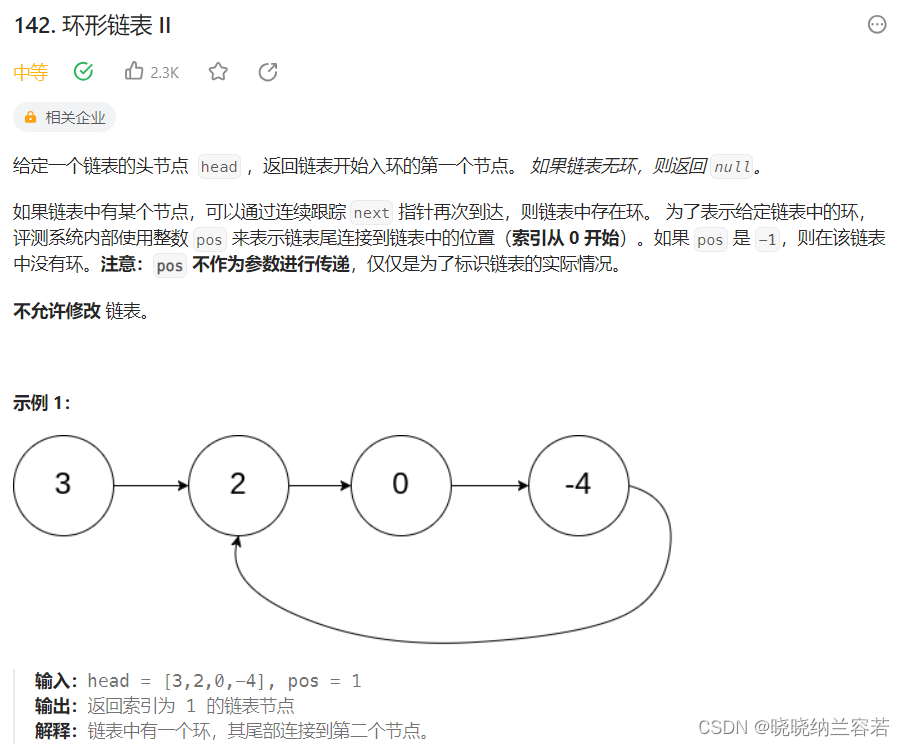
主要思路:
快慢指针,快指针每次走两步,慢指针每次走一步;
第一次相遇时,假设慢指针共走了 f 步,则快指针走了 2f 步;
假设起点到环入口结点的长度为 a(不包括入口结点),环的结点数为 b;快指针比慢指针多走的步数肯定全在环中,则有 2f - f = f = nb;则慢指针共走了 nb 步;
由于慢指针共走了 nb 步,而起点到环入口结点的步数为 a,则实际慢指针在环内走了 nb - a 步;
此时让慢指针从起点重新出发走 a 步,每次走 1 步;快指针从相遇的地方出发,每次也走 1 步,快慢指针必然在环入口结点相遇;因此快指针相当于也走了 a 步,恰好与 nb - a 步互补,构成完整圈数的 nb 环;
#include <iostream>
#include <vector>
struct ListNode {
int val;
ListNode *next;
ListNode(int x) : val(x), next(NULL) {}
};
class Solution {
public:
ListNode *detectCycle(ListNode *head) {
if(head == nullptr) return head;
ListNode *slow = head;
ListNode *fast = head;
while(fast != NULL && fast->next != NULL){
fast = fast->next->next;
slow = slow->next;
if(fast == slow) break; // 第一次相遇
}
if(fast == NULL || fast->next == NULL) return NULL; // 没有环
// 从头开始走
slow = head;
while(slow != fast){
slow = slow->next;
fast = fast->next;
}
// 第二次相遇就是环的入口
return slow;
}
};
int main(int argc, char *argv[]) {
// head = [3, 2, 0, -4], pos = 1
ListNode *Node1 = new ListNode(3);
ListNode *Node2 = new ListNode(2);
ListNode *Node3 = new ListNode(0);
ListNode *Node4 = new ListNode(-4);
Node1->next = Node2;
Node2->next = Node3;
Node3->next = Node4;
Node4->next = Node2;
Solution S1;
ListNode* res = S1.detectCycle(Node1);
if(res != nullptr) std::cout << res->val << std::endl;
else std::cout << "nullptr" << std::endl;
return 0;
}2--LRU缓存(146)
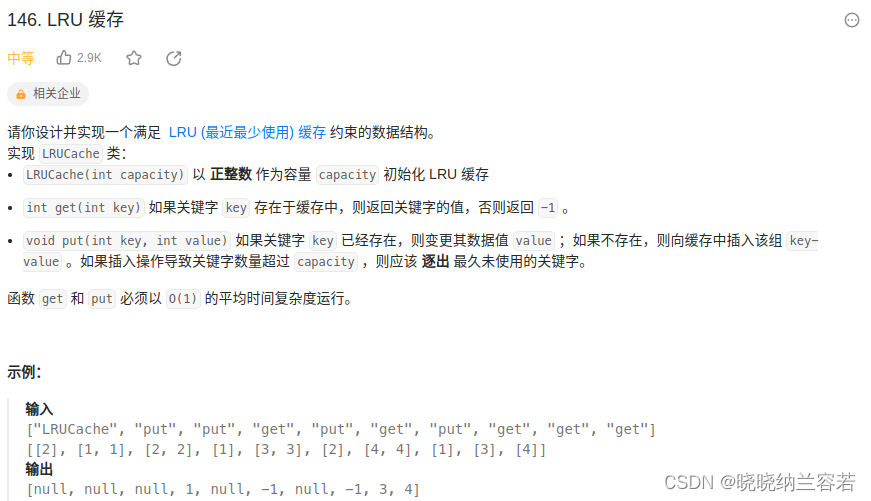
主要思路:
基于双向链表和哈希表;
访问元素时,若元素不存在则返回;若元素存在,则将元素记录,并将元素移动到双向链表头部;(确保访问热度最高的元素放在双向链表头部,访问热度最低的元素放在双向链表尾部);
插入元素时,若元素不存在:当容量已满时,先移除双向链表尾部的元素,再将新元素插入到双向链表头部;若元素存在,则取出元素并更新元素的值,将更新后的元素插入到双向链表头部;
#include <iostream>
#include <unordered_map>
class LRUCache {
public:
struct ListNode{
ListNode(int key, int val){
this->key = key;
this->val = val;
}
ListNode* pre = nullptr;
ListNode* next = nullptr;
int val = 0;
int key = 0;
};
LRUCache(int capacity) {
this->cap = capacity; // 容量
head = new ListNode(-1, -1);
tail = new ListNode(-1, -1);
head->next = tail;
tail->pre = head;
}
int get(int key) {
if(hash.count(key) == 0) return -1; // 元素不存在
ListNode* ptr = hash[key]; // 取出元素
remove(ptr); // 从双向链表中删除元素
insert(ptr); // 将元素插入到双向链表头部
return ptr->val; // 返回元素的值
}
void put(int key, int value) {
if(hash.count(key) == 0){ // 元素不存在
if(hash.size() == cap){ // 容量已满
ListNode* ptr = tail->pre;
remove(ptr); // 去除尾部节点
hash.erase(ptr->key);
delete(ptr);
}
ListNode* new_node = new ListNode(key, value); // 新建节点
insert(new_node); // 插入新节点到头部
hash[new_node->key] = new_node;
return;
}
else{ // 元素存在
ListNode* ptr = hash[key]; // 取出元素
ptr->val = value; // 更新元素
remove(ptr); // 先删除元素
insert(ptr); // 再将元素插入到头部
return;
}
}
void remove(ListNode* ptr){
// 取出前驱和后驱元素
ListNode* a = ptr->pre;
ListNode* b = ptr->next;
// 更新前驱和后驱元素的指向
a->next = b;
b->pre = a;
ptr->pre = ptr->next = nullptr;
}
void insert(ListNode* ptr){
ListNode* tmp = head->next; // 头指针的下一个元素
// 将元素插入到双向链表头部
ptr->pre = head;
head->next = ptr;
ptr->next = tmp;
tmp->pre = ptr;
}
private:
int cap = 0; // 容量
std::unordered_map<int, ListNode*> hash; // 哈希表
ListNode* head; // 双向链表哨兵头节点
ListNode* tail; // 双向链表哨兵尾节点
};
int main(int argc, char argv[]){
return 0;
}
3--排序列表(148)
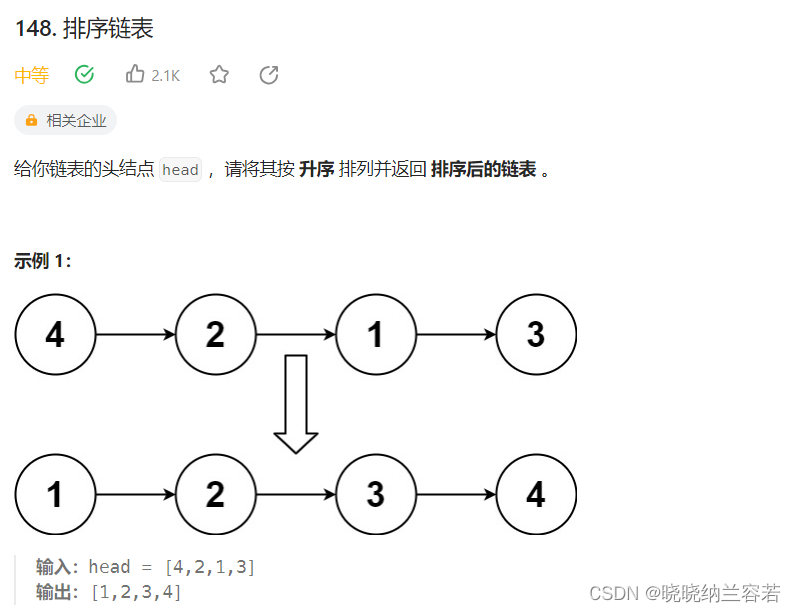
主要思路:
基于归并排序,先二分链表,再对链表进行归并排序;
#include <iostream>
struct ListNode {
int val;
ListNode *next;
ListNode() : val(0), next(nullptr) {}
ListNode(int x) : val(x), next(nullptr) {}
ListNode(int x, ListNode *next) : val(x), next(next) {}
};
class Solution {
public:
ListNode* sortList(ListNode* head) {
return SplitList(head);
}
ListNode* SplitList(ListNode* head){
if(head == nullptr || head->next == nullptr) return head; // 空或者只有一个结点
ListNode* slow = head, *fast = head, *pre = head;
while(fast != nullptr){
pre = slow; // 慢指针的前继指针
fast = fast->next;
slow = slow->next;
if(fast == nullptr) break;
fast = fast->next;
}
pre->next = nullptr; // 断开
return(merge(SplitList(head), SplitList(slow))); // 递归二分至底层,然后归并
}
ListNode* merge(ListNode* head1, ListNode* head2){
ListNode* dummyNode = new ListNode(0);
ListNode *tmp = dummyNode, *tmp1 = head1, *tmp2 = head2;
while(tmp1 != nullptr && tmp2 != nullptr){
if(tmp1->val <= tmp2->val){
tmp->next = tmp1;
tmp1 = tmp1->next;
}
else{
tmp->next = tmp2;
tmp2 = tmp2->next;
}
tmp = tmp->next;
}
while(tmp1 != nullptr){
tmp->next = tmp1;
tmp1 = tmp1->next;
tmp = tmp->next;
}
while(tmp2 != nullptr){
tmp->next = tmp2;
tmp2 = tmp2->next;
tmp = tmp->next;
}
return dummyNode->next;
}
};
int main(int argc, char *argv[]) {
// head = [4, 2, 1, 3]
ListNode* Node1 = new ListNode(4);
ListNode* Node2 = new ListNode(2);
ListNode* Node3 = new ListNode(1);
ListNode* Node4 = new ListNode(3);
Node1->next = Node2;
Node2->next = Node3;
Node3->next = Node4;
Solution S1;
ListNode* res = S1.sortList(Node1);
while(res != nullptr){
std::cout << res->val << " ";
res = res->next;
}
return 0;
}4--乘积最大子数组(152)
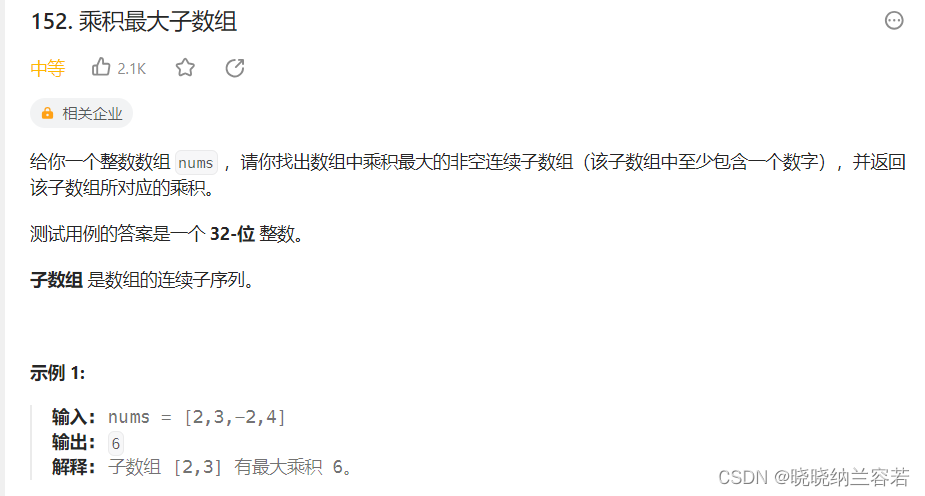
主要思路:
基于动态规划,dp_max[i] 和 dp_min[i] 分别表示以坐标 i 结尾的连续子数组和的最大值和最小值;
状态转移方程:dp_max[i] = std::max(dp_max[i-1] * nums[i], dp_min[i-1] * nums[i], nums[i]);dp_min[i] = std::min(dp_max[i-1] * nums[i], dp_min[i-1] * nums[i], nums[i]);
之所以使用 dp_min[i],是由于会出现负数的情况,当负负得正时会出现更大的连续和,因此要考虑 dp_min[i];
#include <iostream>
#include <vector>
class Solution {
public:
int maxProduct(std::vector<int>& nums) {
std::vector<int> dp_max(nums.size(), 0), dp_min(nums.size(), 0);
dp_max[0] = dp_min[0] = nums[0];
int max = dp_max[0];
for(int i = 1; i < nums.size(); i++){
dp_max[i] = std::max(std::max(dp_max[i-1] * nums[i], dp_min[i-1] * nums[i]), nums[i]);
dp_min[i] = std::min(std::min(dp_max[i-1] * nums[i], dp_min[i-1] * nums[i]), nums[i]);
max = std::max(max, dp_max[i]);
}
return max;
}
};
int main(int argc, char argv[]){
// nums = [2, 3, -2, 4]
std::vector<int> test = {2, 3, -2, 4};
Solution S1;
int res = S1.maxProduct(test);
std::cout << res << std::endl;
return 0;
}
5--最小栈(155)

主要思路:
使用一个辅助栈,记录截止到当前元素的最小值。
#include <iostream>
#include <stack>
class MinStack{
public:
MinStack(){}
void push(int val){
stk1.push(val);
if(stk2.empty() || val <= stk2.top()){
stk2.push(val);
}
}
void pop(){
int top = stk1.top();
stk1.pop();
if(top == stk2.top()) stk2.pop();
}
int top(){
return stk1.top();
}
int getMin() {
return stk2.top();
}
private:
std::stack<int> stk1, stk2;
};
int main(int argc, char argv[]){
return 0;
}
6--相交链表(160)
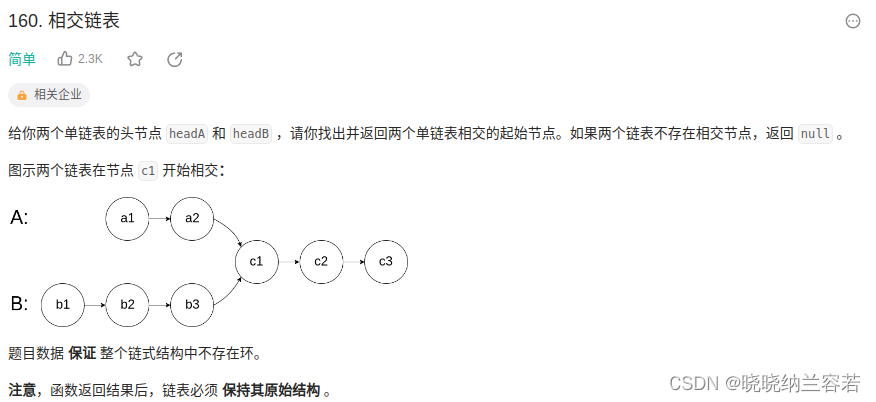
主要思路:
走过自己的路,再走你走过的路,要么在相交的节点相遇,要么都是 nullptr;
非常有哲学意义的一道题!!!!!
#include <iostream>
#include <vector>
struct ListNode{
int val;
ListNode *next;
ListNode(int x) : val(x), next(NULL) {}
};
class Solution{
public:
ListNode *getIntersectionNode(ListNode *headA, ListNode *headB) {
if(headA == nullptr || headB == nullptr){
return nullptr;
}
ListNode* tmp1 = headA, *tmp2 = headB;
while(tmp1 != tmp2){
tmp1 = tmp1->next;
tmp2 = tmp2->next;
if(tmp1 == tmp2) break; // 相遇或同时为null
if(tmp1 == nullptr) tmp1 = headB;
if(tmp2 == nullptr) tmp2 = headA;
}
if(tmp1 == nullptr) return nullptr;
return tmp1;
}
};
int main(int argc, char argv[]){
// intersectVal = 8, listA = [4,1,8,4,5], listB = [5,6,1,8,4,5], skipA = 2, skipB = 3
ListNode *Node1 = new ListNode(4);
ListNode *Node2 = new ListNode(1);
ListNode *Node3 = new ListNode(8);
ListNode *Node4 = new ListNode(4);
ListNode *Node5 = new ListNode(5);
Node1->next = Node2;
Node2->next = Node3;
Node3->next = Node4;
Node4->next = Node5;
ListNode *Node6 = new ListNode(5);
ListNode *Node7 = new ListNode(6);
ListNode *Node8 = new ListNode(1);
Node6->next = Node7;
Node7->next = Node8;
Node8->next = Node3;
Solution S1;
ListNode* res = S1.getIntersectionNode(Node1, Node6);
if(res != nullptr) std::cout << res->val << std::endl;
else std::cout << "null" << std::endl;
return 0;
}
7--多数元素(169)
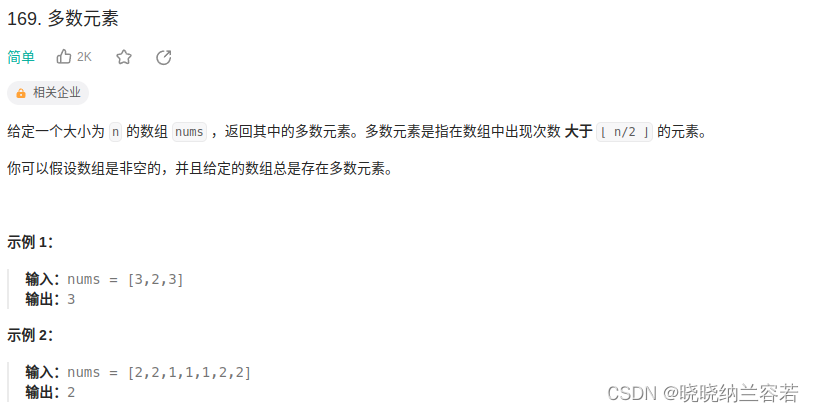
主要思路:
假设有一个桶,当一个桶为空时,放入一个新的元素;当一个桶不为空时,当准备放入一个新的元素时,如果新的元素与桶内的元素不相同,则不放入这个新元素且将桶内的一个元素拿出来;
对于本题,最后桶剩下的元素肯定是多数元素,因为题目规定多数元素必定存在;具体到本题可以用一个计数器表示桶内的元素个数,当计数器为空时可以随意放入新的元素;
#include <iostream>
#include <vector>
class Solution {
public:
int majorityElement(std::vector<int>& nums) {
int count = 0, val = nums[0]; // count 表示桶内元素的个数, val表示桶内的元素值
for(int num : nums){
if(num == val) count++;
else{
if(count == 0){ // 桶为空
val = num;
count = 1;
}
else{ // 桶不为空,抵消一个元素
count--;
}
}
}
return val;
}
};
int main(int argc, char argv[]){
// nums = [3,2,3]
std::vector<int> test = {3, 2, 3};
Solution S1;
int res = S1.majorityElement(test);
std::cout << res << std::endl;
return 0;
}
8--打家劫舍(198)
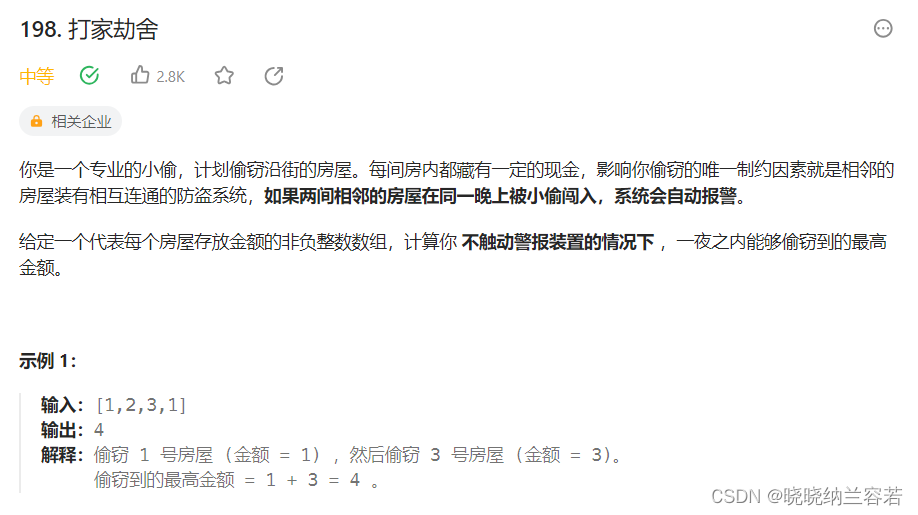
主要思路:
访问到第i间房屋时,设dp[i][0]表示打劫第i间房屋,dp[i][1]表示不打劫第i间房屋,能够获得的最高金额;
状态转移方程 dp[i][0] = dp[i-1][1] + nums[i],dp[i][1] = dp[i-1][0];
#include <iostream>
#include <vector>
class Solution {
public:
int rob(std::vector<int>& nums) {
std::vector<std::vector<int>> dp(nums.size(), std::vector<int>(2, 0));
// 初始化
dp[0][0] = nums[0];
dp[0][1] = 0;
for(int i = 1; i < nums.size(); i++){
dp[i][0] = dp[i-1][1] + nums[i]; // 打劫房屋i,前一间房屋只能不被打劫
dp[i][1] = std::max(dp[i-1][0], dp[i-1][1]); // 不打劫房屋i,前一间房屋可以被打劫也可以不被打劫
}
return std::max(dp[nums.size() - 1][0], dp[nums.size() - 1][1]);
}
};
int main(int argc, char *argv[]) {
std::vector<int> test = {1, 2, 3, 1};
Solution S1;
int res = S1.rob(test);
std::cout << res << std::endl;
return 0;
}9--岛屿数量(200)

主要思路:
深度优先搜索,从(i, j)出发,递归搜索上下左右四个方向的陆地,将相连的陆地置为0;
#include <iostream>
#include <vector>
class Solution {
public:
int numIslands(std::vector<std::vector<char>>& grid) {
int m = grid.size(), n = grid[0].size();
int res = 0;
for(int i = 0; i < m; i++){
for(int j = 0; j < n; j++){
if(grid[i][j] == '1'){
res++;
dfs(grid, i, j);
}
}
}
return res;
}
void dfs(std::vector<std::vector<char>>& grid, int i, int j){
if(i >= grid.size() || j >= grid[0].size() || grid[i][j] == '0' || i < 0 || j < 0) return;
grid[i][j] = '0';
dfs(grid, i+1, j);
dfs(grid, i, j+1);
dfs(grid, i-1, j);
dfs(grid, i, j-1);
}
};
int main(int argc, char *argv[]) {
std::vector<std::vector<char>> test = {{'1', '1', '0', '0', '0'},
{'1', '1', '0', '0', '0'},
{'0', '0', '1', '0', '0'},
{'0', '0', '0', '1', '1'}};
Solution S1;
int res = S1.numIslands(test);
std::cout << res << std::endl;
return 0;
}10--反转链表(206)
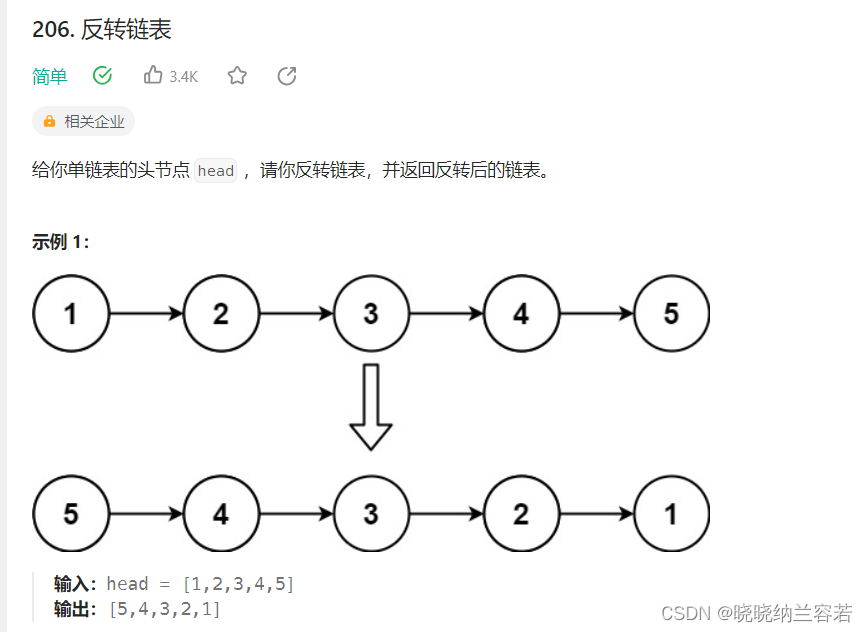
主要思路:
头插法,使用虚拟头节点。
#include <iostream>
struct ListNode {
int val;
ListNode *next;
ListNode() : val(0), next(nullptr) {}
ListNode(int x) : val(x), next(nullptr) {}
ListNode(int x, ListNode *next) : val(x), next(next) {}
};
class Solution {
public:
ListNode* reverseList(ListNode* head) {
if(head == nullptr) return nullptr;
ListNode* FHead = new ListNode(-1); // 虚拟头节点
FHead->next = head;
ListNode* tmp = head->next;
head->next= nullptr;
while(tmp != nullptr){
ListNode* next = tmp->next; // 记录下一个结点
// 头插
tmp->next = FHead->next;
FHead->next = tmp;
// 更新
tmp = next;
}
return FHead->next;
}
};
int main(int argc, char *argv[]) {
ListNode *Node1 = new ListNode(1);
ListNode *Node2 = new ListNode(2);
ListNode *Node3 = new ListNode(3);
ListNode *Node4 = new ListNode(4);
ListNode *Node5 = new ListNode(5);
Node1->next = Node2;
Node2->next = Node3;
Node3->next = Node4;
Node4->next = Node5;
Solution S1;
ListNode *res = S1.reverseList(Node1);
ListNode *tmp = res;
while(tmp != nullptr){
std::cout << tmp->val << " ";
tmp = tmp->next;
}
return 0;
}




















 234
234











 被折叠的 条评论
为什么被折叠?
被折叠的 条评论
为什么被折叠?








